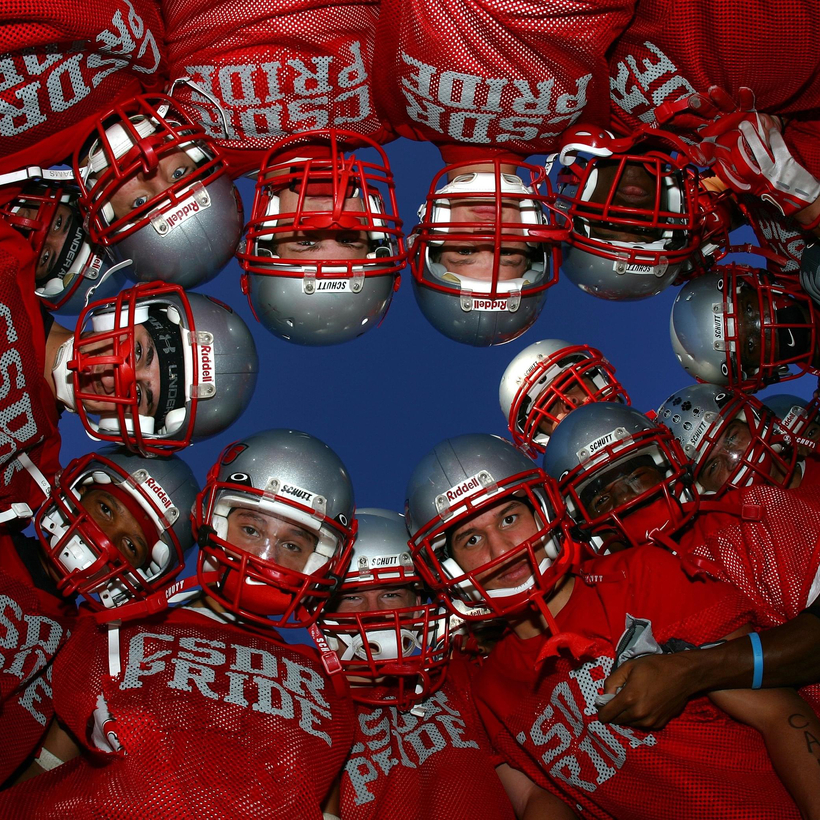Following his team’s 80–26 loss to the California School for the Deaf’s Cubs, A. C. Swadling, a star football player from the opposing school, Faith Baptist, called out to each of the victors, channeling the feathery-haired villainy of a John Hughes–type bully. “You can hear me?,” Swadling asked, displaying his disbelief in losing the 2022 California eight-player high-school championship to a deaf team. “You can hear me, right?”
No, they could not. Initially confused by his accusation, the players let it go—moving on to enjoy their triumph and an undefeated season.
Sadly, Swadling’s tantrum accounts for one of the few gems in Thomas Fuller’s The Boys of Riverside: A Deaf Football Team and a Quest for Glory, a haphazard story of the Cubs’ two-year pursuit of a championship win.
Fuller, a correspondent for The New York Times, began writing about the Cubs late in their 2021 season, during which they reached their first championship only to lose 74–22 to Faith Baptist’s team. But by then, more than those who follow the sport of eight-man football had started to pay attention. The Cubs were national darlings.
They left Fuller in a lavender haze. Watching them caused him to go full-on Friday Night Lights. Taking leave of his job as the paper’s San Francisco bureau chief, he moved to Riverside in order to follow the Cubs for their 2022 season.

And why not? It was all there! Fuller had deaf athletes on a team with a long history of failure who were looking to finish the ultimate task: win the big game. Before 2021, the Cubs had posted seven consecutive losing seasons. Now they had become a juggernaut humiliating non-deaf teams. (Fuller explains this turnaround as better training combined with the use of sign language and other nonverbal tactics in play-calling.)
We’ve come to expect much from the “in season with high-school teams” genre. While Buzz Bissinger’s 1990 masterpiece on Odessa, Texas’s Permian Panthers might have spoiled us, we’ve certainly settled for less. Hell, we even fell for the kids from MTV’s reality show Two-a-Days, which captured life inside Alabama football powerhouse Hoover High.
We love these stories in every form. Done well, they give us insight into the inner lives of teenagers as well as the coaches leading them, the communities counting on them, and the power of sport.
“In reporting the book,” Fuller writes early on, “I came to see the Cubs as a flesh-and-blood realization of the American dream.”
We’ve come to expect much from the “in season with high-school teams” genre.
While Fuller introduces a great many players with a great many backgrounds, they flicker only briefly. One young man, whom he features early in the book, lives in his car close to a Target for the 2021 season. But when he’s forced to leave the team before the following year due to his poor performance in school, he vanishes entirely from our view.
Even coach Keith Adams, himself deaf, gets lost here. Whatever long-lasting memories we might have of him are stamped out by extensive lessons on deaf history and Fuller’s overuse of play-by-play from the field and game stories.
Fuller does provide a peek into the 21st-century media-mania that the Cubs inspired. After all, it’s one he helped create. From the team’s first appearance in The New York Times, national media outlets set their sights on them. Both Today and Good Morning America came calling. So did Kelly Clarkson.

But the most surreal moment in The Boys of Riverside comes with the arrival of the NFL Films crew during the 2022 season. The league’s in-house production company pops up in the locker room to film a feature on the Cubs. Soon, the mythmakers—the same group that pumps out Hard Knocks—will make them part of football canon. The Cubs will remain on loop as those inspiring icons for decades, whether they want to or not.
But first there’s the obligatory pre-game speech by Adams. (He signed it, while the team’s interpreter read it aloud.) The production crew has prepped him for this. He must deliver an all-timer.
It comes out … not great.
It’s not enough. Dissatisfied with the footage, the NFL Films crew returns later—this time with a pre-written address for Adams. Fuller admits the second attempt is better, even if it “seemed to strain the truth slightly.” However, the emotional response it gets from his kids is very real. They believe in this man.
It’s no surprise it worked. NFL Films understands dialogue and scenes and those small moments that stay with us. Its cinematic portrayal of football’s heroes and villains helped grow the game for more than five decades. It gets how to craft a compelling sports narrative.
Sridhar Pappu is a journalist and the author of The Year of the Pitcher: Bob Gibson, Denny McLain, and the End of Baseball’s Golden Age

